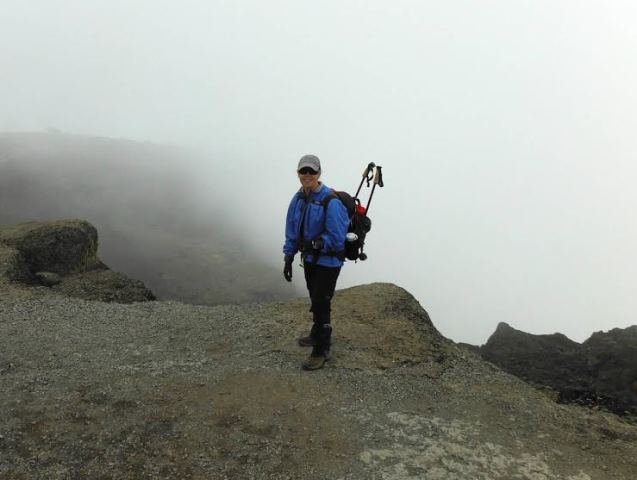By George Henson
Bertha De La Garza ascended to loftier heights than before by climbing Africa’s Mount Kilimanjaro this summer. The Baptist from Abilene, Texas, also reached new spiritual heights during the hike, which raised money for a global sports ministry.
De La Garza, associate athletic trainer at Hardin-Simmons University, participated in the climb to raise funds for the International Sports Federation, a nonprofit organization dedicated to using sports to build relationships in cross-cultural settings as a way to share the gospel.
“This was a charity climb,” she said. “Most people may do a charity walk or a charity run, but instead of doing 5K horizontally, we went vertically.”
De La Garza, who attends South Side Baptist Church in Abilene, began her association with the organization in 2006.
 “I was wondering, ‘How can I use my skills as an athletic trainer to do ministry?’” she said. “And a little while later, I received an email from someone I didn’t know about using athletic training skills for ministry. What are the chances of that happening? So, I knew it was divine.”
“I was wondering, ‘How can I use my skills as an athletic trainer to do ministry?’” she said. “And a little while later, I received an email from someone I didn’t know about using athletic training skills for ministry. What are the chances of that happening? So, I knew it was divine.”
In 2007, she took her first trip with the group to Poland, participating in recreational sports ministry. She maintained her connection with the group, helping to train groups prior to leaving for overseas destinations.
Generally, the ministry forms relationships through sports and then refers the people to a missionary who teaches them English. Those English lessons form the basis of relationships through which the gospel can be shared.
The ministry uses a variety of avenues — from basketball to mountain biking to alpine skiing — to attract the interest of sports-minded people with the goal of sharing the love of Christ. They also are involved in humanitarian aid activities such as clean-water projects.
Since 1993, International Sports Federation has mobilized more than 8,500 volunteers in more than 120 countries around the world.
The Kilimanjaro trip represented a different type of endeavor. Rather than ministry, the focus was raising funds to help others afford to go and minister in the future.
‘We made it’
Each climber committed to raise $10,000 — about half of which went to pay for their climb, and the other half to International Sports Federation to provide scholarships for volunteers needing financial assistance.
Since the $10,000 figure was significant, and “I don’t like to ask for help,” De La Garza said she kind of dragged her feet raising funds until about six months before the trip.
She decided she would fund the $5,000 needed for the climb and only ask others for the portion of the money that would support the organization.
The Hardin-Simmons women’s soccer team was one of the donors. The university women gathered $400 to give to the cause.
“It was amazing. I had no idea they were going to do that,” she said. “They really played a big role in just that they were conscientious enough to do that.”
As word got out, others not only gave money, but also offered prayer.
“I think that was really important, because we made it,” she said with a broad smile.
Training for the climb was a challenge. For one thing, there aren’t even many big hills around Abilene. For another, when De La Garza had her lung capacity tested, she didn’t even rank on the “very poor” scale.
“That’s how poor my cardio was,” she said.
‘You and your trekking poles’
After three months of training — many times driving two or three hours to find trails with a fairly steep incline — her fitness had improved greatly, but she still had no substitute for the altitude of Kilimanjaro.
To mimic the heights, she began wearing a device that limited the amount of oxygen available to her as she trained. It was only the last week or two before leaving for the climb that she reached the scarcity of oxygen she experienced in Tanzania.
Few climbers had experience with scaling peaks. “Mount Kilimanjaro does not require high mountain climbing skills or equipment to climb. It is the highest mountain there is to climb without using that specialized equipment. Basically, it’s you and your trekking poles,” De La Garza explained.
The primary obstacles are endurance, fitness and reaction to the high altitude and limited oxygen available. That doesn’t mean the climb was easy, however. Sometimes it took eight hours to make a vertical climb of three miles. Some days, hikes lasted 10 to 12 hours.
“There was very little down time. Pretty much you hiked to where to camp, ate your dinner and went to your tent to sleep and prepare for the next day,” she said.
‘More than all we ask or imagine’
The devotions for the week centered on the book of Ephesians, and De La Garza said the encouragement found there was important to her making the summit. The last 300 yards to the summit were some of the hardest for her, but the Apostle Paul’s words “he will do more immeasurably more than all we ask or imagine” ran through her mind and gave her the strength to complete the climb.
Many times during the climb, she looked up and saw the mountain before her and was awed by its size and majesty. That prompted her to feel overwhelmed with the difficulty of traversing it.
“Every time, God would bring a cloud and cover it up before I could be really discouraged. I would be like, ‘good job, God.’”
